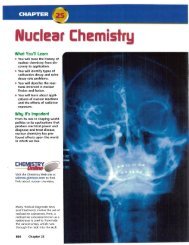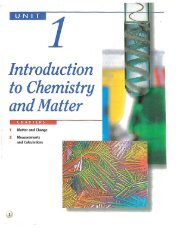Solutions
Solutions
Solutions
You also want an ePaper? Increase the reach of your titles
YUMPU automatically turns print PDFs into web optimized ePapers that Google loves.
Percent by volume usually describes solutions in which both solute and solvent<br />
are liquids. The percent by volume is the ratio of the volume of the solute<br />
to the volume of the solution expressed as a percent. The volume of the solution<br />
is the sum of the volumes of the solute and the solvent. Calculations are<br />
similar to those involving percent by mass.<br />
volume of solute<br />
Percent by volume = 1 fIt' X<br />
vo ume<br />
100<br />
0 so u lOn<br />
Rubbing alcohol is an aqueous solution of liquid isopropyl alcohol. The<br />
label on a typical container, such as the one shown in Figure 15-12, usually<br />
states that the rubbing alcohol is 70% isopropyl alcohol. This value is a percent<br />
by volume. It tells you that 70 volumes ofisopropyl alcohol are dissolved<br />
in every 100 volumes of solution. Because a solution's volume is the sum of<br />
the volumes of solute and solvent, there must be 30 volumes of water (solvent)<br />
in every 100 volumes of the rubbing alcohol.<br />
PROBLEMS<br />
11. What is the percent by volume of ethanol in a solution that contains<br />
35 mL of ethanol dissolved in 115 mL of water<br />
12. If you have 100.0 mL of a 30.0% aqueous solution of ethanol, what<br />
volumes of ethanol and water are in the solution<br />
13. What is the percent by volume of isopropyl alcohol in a solution that<br />
contains 24 mL of isopropyl alcohol in 1.1 L of water<br />
Molarity<br />
As you have learned, percent by volume and percent by mass are only two<br />
of the commonly used ways to quantitatively describe the concentrations of<br />
liquid solutions. One of the most common units of solution concentration is<br />
molarity. Molarity (M) is the number of moles of solute dissolved per liter<br />
of solution. Molarity also is known as molar concentration. The unit M is read<br />
as molar. A liter of solution containing one mole of solute is a 1M solution,<br />
which is read as a one molar solution. A liter of solution containing 0.1 mole<br />
of solute is a O.lM solution.<br />
To calculate a solution's molarity, you must know the volume of the solution<br />
and the amount of dissolved solute.<br />
Molarit (M) = ~oles of sol~te<br />
y liters of solution<br />
:. RUBEFACIENT JTOPICAL ANTI""CROE1~l<br />
32 FL OZ (1 an 946 mL<br />
For example, suppose you need to calculate the molarity of 100.0 rnL of an<br />
aqueous solution containing 0.085 mole of dissolved potassium chloride<br />
(KCl). You would first convert the volume of the solution from milliliters to<br />
liters using the conversion factor 1 L = 1000 rnL.<br />
Figure 15·12<br />
The composition of this isopropyl<br />
alcohol is given in percent by volume,<br />
which is often expressed as<br />
% (v/v). What does each v in the<br />
expression 70% (vJv) refer to<br />
(l00)Rl::) (lOJo~,)= 0.1000 L<br />
Then, to determine the molarity, you would divide the number of moles of<br />
solute by the solution volume in liters.<br />
0.085 mol KCI<br />
0.1000 L solution<br />
0.8tmol = 0.85M<br />
464 Chapter 15 <strong>Solutions</strong>












